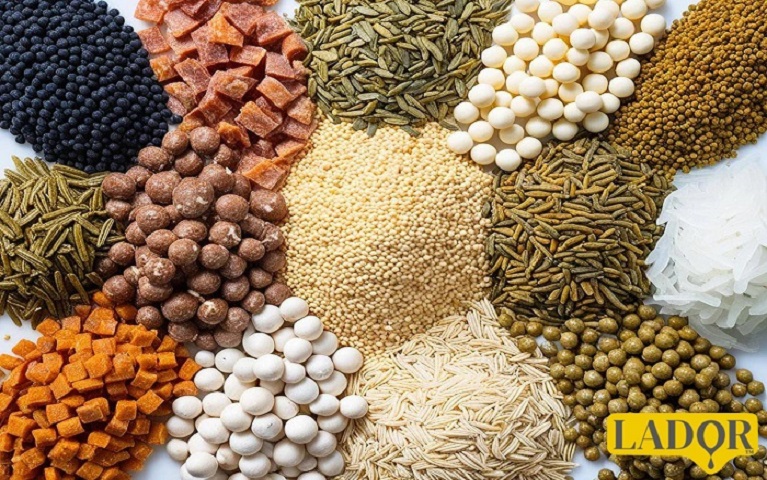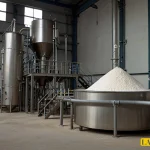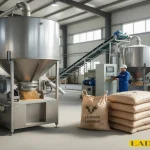Ready-feed for livestock is a complete nutritional formula designed specifically for feeding livestock. This type of feed contains all the essential nutrients necessary for the growth, milk production, meat production, and wool production of animals. It is available in dry or wet form, as pellets, or in powder form. In the following sections of this article, we will discuss the different types of ready-to-feed animal feed, its composition, and its benefits.
Main Ingredients of Ready-to-feed Animal Feed
The main ingredients of ready-to-feed animal feed can be broadly classified into two categories:
- Energy sources: Grains such as corn, wheat, barley, and rice, which are the primary sources of energy for animals.
- Protein sources: Oilseed meals like soybean, canola, and sunflower, which contain plant-based proteins, as well as some animal by-products such as meat and bone meal.
In addition to these, other substances include:
- Minerals: Phosphorus, calcium, sodium, potassium, and more, for building bones and teeth, and for proper bodily function.
- Vitamins: A, D, E, K, and B vitamins for growth, reproduction, and immune system function.
- Additives: Enzymes, probiotics, antibiotics, and other substances to improve digestion, boost the immune system and increase production.

Constituents of Ready-to-feed Animal Feed
The constituents of ready-to-feed animal feed vary depending on the type of animal and the specific formulation. Some of the main constituents of these feeds include:
- Grains such as corn, wheat, barley, rice
- Soybean meal, sunflower meal
- Mineral supplements including phosphorus, calcium, sodium
- Vitamins A, D, E, K
- Additives such as enzymes, probiotics, antibiotics
The Preparation of Commercial Animal Feed
The production of commercial animal feed is a rigorous process that involves several stages aimed at providing livestock with a complete and balanced diet. It typically involves the following steps:
Formulation
- Nutritional Requirement Determination: The specific nutritional needs of the animals are determined based on factors such as age, breed, production stage (growth, lactation, gestation), and environmental conditions.
- Raw Material Selection: Suitable raw materials are chosen based on the formulation, including grains (corn, wheat, barley), oilseed meals (soybean, sunflower), mineral and vitamin supplements, and other additives.
- Ingredient Ratio Determination: The exact proportion of each ingredient in the formulation is determined to ensure the final feed is nutritionally balanced.
Raw Material Preparation
- Sourcing: Raw materials are sourced from reliable and high-quality suppliers.
- Cleaning and Conditioning: Raw materials are cleaned, dried, and ground or milled as needed before use.
Mixing
- Grinding: Raw materials are ground to a suitable particle size to ensure a uniform mix.
- Mixing: The ground materials are thoroughly mixed with supplements and additives.
- Quality Control: The quality of the mix is checked for uniformity and composition.
Pelletizing (if required)
- Cooking: The mixture is cooked using steam to preserve nutrients and kill bacteria.
- Pelletizing: The cooked mixture is pressed and heated to form small pellets. Pellets improve digestibility and reduce feed wastage due to their shape and size.
- Cooling: The produced pellets are cooled before packaging.
Packaging
- Bagging: Pellets are packed in multi-layer, resistant bags to prevent moisture, air, and contamination.
- Labeling: Each bag is labeled with information such as feed type, production date, expiration date, manufacturer, and feeding instructions.
Storage and Distribution
- Storage: The prepared feed is stored in dry and cool conditions to maintain quality.
- Distribution: The packaged feed is distributed to livestock farms.
Why Use Commercial Feed for Livestock?
Commercial feed is formulated to meet all the nutritional needs of livestock, preventing deficiencies. By using commercial feed, livestock farmers can save time that would otherwise be spent preparing feed rations and combining various raw materials. Additionally, the precise formulation of commercial feed leads to increased milk, meat, and wool production in animals. The additives present in commercial feed help improve animal health, increase resistance to diseases, and reduce mortality rates.
Types of Commercial Livestock Feed
Commercial livestock feed is categorized into various types based on the type of animal (cattle, sheep, poultry, etc.), the animal’s age, production stage (growth, lactation, pregnancy), and environmental conditions. Some common types of commercial feed include:
- Concentrate: High in energy and protein but low in fiber, used to provide the energy needs of livestock.
- Hay: Consists of dried alfalfa, clover, and other plants, serving as the primary source of fiber in livestock diets.
- Silage: Fermented forage produced under anaerobic conditions, used as a substitute for hay.
- Complete feed: A mixture of concentrate and forage, prepared in a uniform and ready-to-feed form for livestock.
Factors Affecting the Quality of Commercial Feed
- Quality of raw materials: The quality of the ingredients used in the feed directly impacts the overall quality of the final product.
- Formulation accuracy: Precise formulation ensures that the feed meets the specific nutritional requirements of the target animals.
- Suitable equipment: The use of appropriate equipment during the manufacturing process is essential for maintaining product quality.
- Quality control throughout all stages: Continuous monitoring of the production process is crucial to guarantee the consistent quality of the final feed.
Important Points to Consider When Using Commercial Animal Feed
Choosing the Right Feed: When selecting a suitable feed for your livestock, factors such as the animal’s species, age, breed, production stage, and environmental conditions must be taken into account.
Paying Attention to Feed Quality: The quality of commercial feed is of paramount importance. Therefore, purchase feed from reputable and high-quality producers.
Following Feeding Instructions: To achieve the best results, carefully read and follow the feeding instructions provided on the feed packaging.
Providing Sufficient Water: Ensuring an adequate water supply for your animals, aids in better feed digestion and maintains their overall health.

About Sepahan oil factory
Ala Sepahan Oil Company under the Lador brand, as one of the leading and specialized producers in the field of animal feed, utilizes up-to-date knowledge, modern processing, and strict quality control to offer products aimed at meeting the nutritional needs of livestock with the best quality and economic price. Some of Ladorfat’s products include Fat Powder Omega 3, Calciumized Fat Powder Plus, Aleppo cattle Oil, raw materials and additives for preparing ready-made feed for dairy and beef cattle, turkey feed, Feed for fattening calves, and others.
Conclusion
Due to their precise formulation, uniformity, and high-quality control, commercial animal feeds can contribute to improved production performance, health, and well-being of livestock. However, traditional feeding practices may also be suitable in certain circumstances and for specific animals. Contact our experts in Ladorfat for price inquiries and advice.



